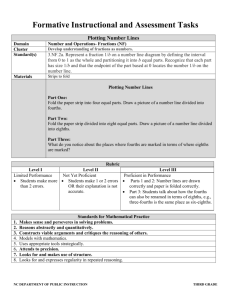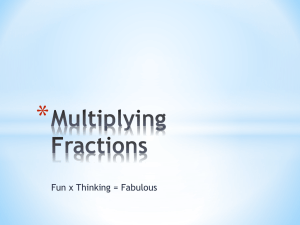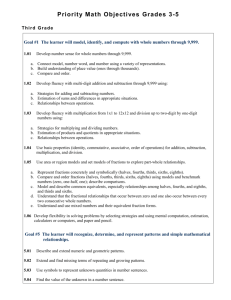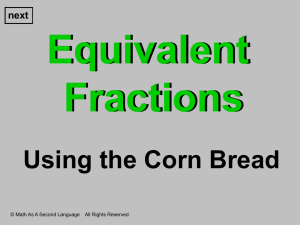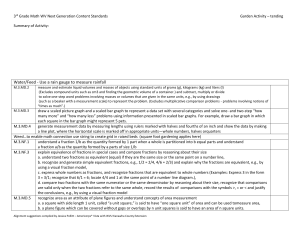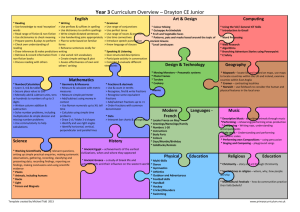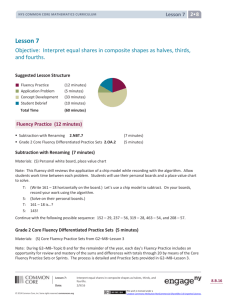Grade 5 Module 3 Facilitator`s Guide
advertisement
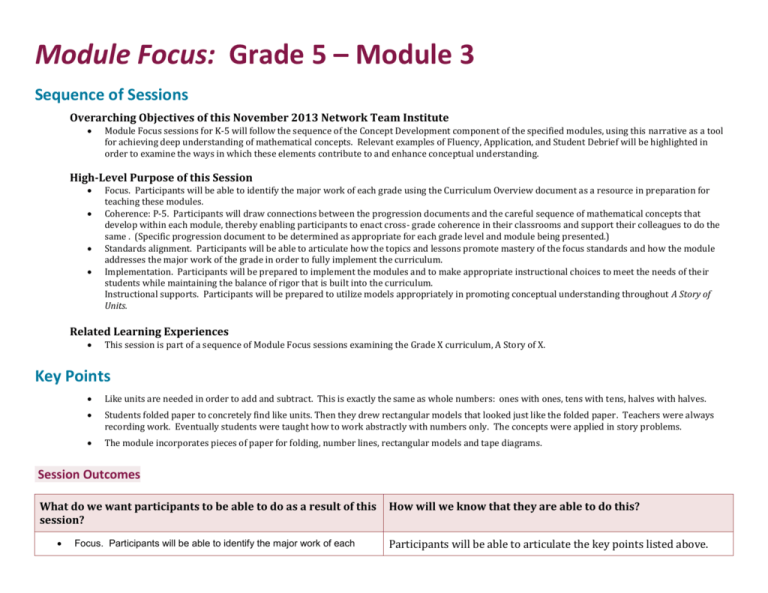
Module Focus: Grade 5 – Module 3 Sequence of Sessions Overarching Objectives of this November 2013 Network Team Institute Module Focus sessions for K-5 will follow the sequence of the Concept Development component of the specified modules, using this narrative as a tool for achieving deep understanding of mathematical concepts. Relevant examples of Fluency, Application, and Student Debrief will be highlighted in order to examine the ways in which these elements contribute to and enhance conceptual understanding. High-Level Purpose of this Session Focus. Participants will be able to identify the major work of each grade using the Curriculum Overview document as a resource in preparation for teaching these modules. Coherence: P-5. Participants will draw connections between the progression documents and the careful sequence of mathematical concepts that develop within each module, thereby enabling participants to enact cross- grade coherence in their classrooms and support their colleagues to do the same . (Specific progression document to be determined as appropriate for each grade level and module being presented.) Standards alignment. Participants will be able to articulate how the topics and lessons promote mastery of the focus standards and how the module addresses the major work of the grade in order to fully implement the curriculum. Implementation. Participants will be prepared to implement the modules and to make appropriate instructional choices to meet the needs of their students while maintaining the balance of rigor that is built into the curriculum. Instructional supports. Participants will be prepared to utilize models appropriately in promoting conceptual understanding throughout A Story of Units. Related Learning Experiences This session is part of a sequence of Module Focus sessions examining the Grade X curriculum, A Story of X. Key Points Like units are needed in order to add and subtract. This is exactly the same as whole numbers: ones with ones, tens with tens, halves with halves. Students folded paper to concretely find like units. Then they drew rectangular models that looked just like the folded paper. Teachers were always recording work. Eventually students were taught how to work abstractly with numbers only. The concepts were applied in story problems. The module incorporates pieces of paper for folding, number lines, rectangular models and tape diagrams. Session Outcomes What do we want participants to be able to do as a result of this session? Focus. Participants will be able to identify the major work of each How will we know that they are able to do this? Participants will be able to articulate the key points listed above. grade using the Curriculum Overview document as a resource in preparation for teaching these modules. Coherence: P-5. Participants will draw connections between the progression documents and the careful sequence of mathematical concepts that develop within each module, thereby enabling participants to enact cross- grade coherence in their classrooms and support their colleagues to do the same . (Specific progression document to be determined as appropriate for each grade level and module being presented.) Standards alignment. Participants will be able to articulate how the topics and lessons promote mastery of the focus standards and how the module addresses the major work of the grade in order to fully implement the curriculum. Implementation. Participants will be prepared to implement the modules and to make appropriate instructional choices to meet the needs of their students while maintaining the balance of rigor that is built into the curriculum. Instructional supports. Participants will be prepared to utilize models appropriately in promoting conceptual understanding throughout A Story of Units. Session Overview Section Time Overview Prepared Resources Module 3 Overview Overview of the instructional focus of Grade 5 Module 3. Grade 5 Module 3 Grade 5 Module 3 PPT Lesson StudyDemonstration and Practice Examination of the development of mathematical understanding across the module using a focus on Concept Development within the lessons. Grade 5 Module 3 Grade 5 Module 3 PPT Module Review Articulate the key points of this session. Grade 5 Module 3 Grade 5 Module 3 PPT Facilitator Preparation Review Grade 5 Module 3 Overview, Topic Openers, and Assessments. Session Roadmap Section: Module 3 Overview Time: X minute – HAVE ASKED G5 to add timing not [minutes] In this section, you will… Materials used include: Provide an overview of the instructional focus of Grade 1 Module 3. Time Slide # Slide #/ Pic of Slide Script/ Activity directions 0 1 The name of this module is Addition and Subtraction of Fractions. This module has 16 lessons (divided into Topics A - D), and two assessments, taught over 22 days. After Topic B, there is a mid-module assessment, and after Topic D there is an End-of-Module Assessment. 1 2 Give participants time to read the objectives. GROUP 0 3 Fraction instruction is introduced informally in Grade 2, when students divide geometric shapes into equal parts. They also learn that two halves could have two different shapes. Grade 3 teaches fractions as Numbers on the Number Line, and Grade 4 progresses to Fraction Equivalence, Ordering and Operations. This module builds on that background. 0 4 This is the plan for studying this module: • We’ll read the overview, and then study specific lessons. We’ll model instructional strategies for key concepts in lessons 1, 3, 7, 8. Teachers will have an opportunity to practice on lessons 2, 4, 6, 9, 11, and 15. 0 5 One of the key ideas in this module is that fractions behave the exact same way that whole numbers behave. In order to add or subtract fractions, they must be like units: Ones added to ones, tens added to tens, thirds added to thirds. Section: Lesson Study- Demonstration and Practice Time: [minutes] In this section, you will… Examine the development of mathematical understanding across the module using a focus on Concept Development within the lessons. Materials used include: Time Slide Slide #/ Pic of Slide # X 6 Script/ Activity directions Model this problem as a teacher would with fifth grade students. The following script is included in the CD to serve as one possible way to guide students’ thinking. Materials: (S) 4 Paper strips sized 4 1/4 x 1 per student (vertically cut an 8 ½” x 11” paper down the middle) Problem 1 T: Take your paper strip. Hold it horizontally. Fold it vertically down the middle. How many equal parts do you have in the whole? S: 2. T: What fraction of the whole is 1 part? S: 1 half. T: Draw a line to show where you folded your paper and label each half 1/2, one out of 2 units. T: As you did in fourth grade, take about 2 minutes to make paper strips to also show thirds, fourths, and fifths. T: (After about 3 minutes to make the paper strips.) Draw a number line that is a little longer than your paper strip. Use your strip as a ruler to mark zero and 1 above the line, below the line. T: (After doing so.) Make about an inch by inch square beneath your line. This is representing the same 1 whole as the number line. For today, show half by vertically dividing the square. Shade 1 half on the left. T: (After discussion.) Draw another square to the right of that one. Shade it in the same way to represent 1/2. T: Partition it horizontally across the middle. T: What fraction is shaded now? S: or . T: (Record numerically referring to the picture) 1 group of 2 out of two groups of 2 . T: Explain how we have represented the equivalent fractions to your part. T: Show me on the number line. (Students show.) Yes, it is the exact same number as 1 half, the exact same point on the number line. GROUP T: Work with your partner to draw another congruent square with 1 half shaded. This time partition it horizontally into 3 equal units (2 lines) and record the equivalent fraction as we did on the first example. If you finish early, continue the pattern. 0 7 This is another example from Lesson 1. The intention here is to find an equivalent fraction for a fraction greater than one. Ask participants to explain the model. In the module, on page 3.A.6, a script expresses what one teacher might say. X 8 This is an opportunity for participants to practice the strategies just demonstrated in Lesson 1. The facilitator should circulate, and model how the teacher might get students to articulate their thinking. X 9 If you were the teacher of this lesson, why might you use the number line? Students are familiar with it from previous grade levels. We’ve used it for many concepts, so it helps students make connections. For example when we studied decimals, students discovered that 12 tenths is equivalent to one and two tenths. Let’s look at the solution for Problem 4 in the Problem Set of L2. The number line shows skip counting by 5 eighths, for 4 jumps, stopping at 20 eighths. We see how unit form helps students arrive at a correct answer regardless of whether or not they can rename the fractions as a mixed number. Renaming the fraction on the number line shows the equivalence. In previous grades, students have done this exact activity: hopping from number to number on the open number line (grade 2). X 10 To activate students’ prior knowledge, remind them that they know when adding 3-digit whole numbers, they add ones with ones, tens with tens, and hundreds with hundreds. Ask: Can we add thirds and fourths? (No, we need like units.) Problem 2 in the CD of L3, asks students to add fractions with unlike units. This problem is modeled for the participants using a procedure similar to this sequence. This is written in the script of the CD. • Hand out two identical rectangles for each participant. • Fold one rectangle into thirds, and shade one third. • Fold the other rectangle into halves and shade one half. • Ask: Can we add thirds and halves? (No, we need like units.) • In order to make like units, fold the rectangle showing one third in half. We are dividing each third into 2 equal parts. • Fold the halves into three equal parts. • Ask: What does each rectangle now show? (Sixths) • Ask: Can we now add? (Yes, we have like units.) 0 11 L3, CD, Problem 4 In Problem 3, students used paper to work concretely. Problem 4 demonstrates how students can do the same process pictorially (representationally.) This slide shows how two identical rectangles (two identical wholes) are shaded to show 2/5 and 2/3. Since we need like units in order to add, we divide each rectangle into fifteenths. In order to find fifteenths, we divided the fifths into 3 equal parts, and then the thirds into 5 equal parts, resulting in fifteenths in both wholes. Now we can add. X 12 Follow the directions on the slide. Give participants about 5 minutes. X 13 This slide shows an example of student work for L4, PS, Problem 1. It’s found on page 3.B.25. • How is L4 different from L3? • The sums are less than 1 in L3, and greater than 1 in L4. • What model was used to solve this problem? How was it helpful? • The rectangular model helped to find like units. • What process was used to rename 7-sixths? • Number bonds. Number bonds are introduced in Kindergarten. • Would you use these same questions with fifth grade students? (I would.) X 14 Follow the directions on the slide. Give participants about 5 minutes. X 15 Encourage participants to analyze student thinking. • How are these two solutions the same? • (They both use rectangular models to find like units. The both rename 1 1/3 into 8 sixths.) • How are these two solutions different? • (The first one uses number bonds to rename 1 1/3 as 6/6 + 2/6. The student knew that 6/6 – 3/6 was 3/6, and then added the remaining 2/6. This strategy is similar to the strategy learned in early grades when students learn to take from ten. In grade five, students are using the same thinking. Now they are taking from one whole.) • (The second one found like units, and renamed both the minuend and subtrahend. Then subtracted like units.) X 16 Give participants a few minutes to solve this problem. Possible questions for participants: • Can you solve this problem using both a tape diagram and a rectangular model? • Referring to Table 1 in the CCLS, what’s the situation? (It’s a Take From situation. The total is given, and students have to identify a missing part.) 0 17 Analyze the process of each solution. Did any participant solve in another way? 0 18 Model this problem as a teacher would with fifth grade students. The following script is included in the CD to serve as one possible way to guide students’ thinking. Problem 1 Draw a line or project the number line template. T: Start at zero. Travel one unit. T: Start at 1 and travel one more equal unit. Where do we land? S: 2. T: How much more do I need to travel to get the whole? S: 3 fourths. T: Will that additional distance be less than or more than one whole unit? S: Less than one whole unit. T: Make 3 smaller equal units, 1 fourth, 2 fourths, 3 fourths. What is 2 plus 3 fourths? S: 2 and 3 fourths. S: 1 plus 1 and 3 fourths equals 2 and 3 fourths. X 19 This is another example form L8. The following script is included in the CD to serve as one possible way to guide students’ thinking. Problem 5 T: Let’s say this subtraction sentence. S: 3 minus 1 and 2 thirds. T: First, we will subtract the whole number 1 and then subtract the fraction 2 thirds. Start with 3 on the number line and subtract 1 whole. (Show the subtraction of the unit.) T: When you subtract the fraction 2 thirds, what 2 whole numbers will your answer lie between? S: Between 1 and 2. T: You have 1 minute to complete this problem with your partner. X 20 Follow the directions on the slide. Give participants about 5 minutes. X 21 Problem 4 has 3 addends, but still needs a common unit in order to add. • What patterns have you observed about the common units. • All the new units we found are common multiples of our original units. • We don’t always have to multiply the original units to find a common multiple. • You can skip count by the largest common unit to find smaller common units. • What strategies can students use to find common multiples? (Some possible answers.) • List the multiples and find a common one; the smaller the better. • Use three number lines to skip count. • Multiply each denominator by the product of the other two. If we were folding paper, I’d have to fold the thirds into 4 equal parts, then the twelves into 2 equal parts. This gets complicated, so doing the multiplication is easier. X 22 Follow the directions on the slide. Give participants about 5 minutes. X 23 Encourage participants to analyze student thinking. Possible Answers: They are alike • Because they all have the same minuend and subtrahend. • Because they are using numerical models, not concrete manipulatives or drawings. The are different • Because Model 1 uses a number bond to first subtract 2 ½ from 3, and then add 3/5. Just like in earlier grades when students learn to take from 10, this student is taking from the whole number, and then adding the rest of the minuend. • Because Model 2 first subtracts 2 from 3 to get 1 2/3, and then subtracts the remaining ½ of the subtrahend. In order to subtract ½ from 3/5, the student finds the like units of tenths. • Because Model 3 renames both mixed numbers as fractions. Then this student finds like units, and subtracts. Finally, the student renames 11/10 as a mixed number. X 24 Possible questions for participants: • Can you draw a tape diagram that matches this problem? • Referring to Table 1 in the CCLS, what is this situation? • This is a multiple step question. The first situation is an Add To. The second step requires students to Take Apart in order to find the missing addend. 0 25 Sample solutions. Ask participants to explain each approach. Section: Module Review Time: 5.5 minutes [minutes] In this section, you will… Materials used include: Time Slide Slide #/ Pic of Slide # Script/ Activity directions GROUP 2.5 26 3 27 28 See the next slide for possible answers. • Encourage other answers. Use the following icons in the script to indicate different learning modes. Video Reflect on a prompt Turnkey Materials Provided ● Grade 5 Module 3 PPT Additional Suggested Resources ● A Story of Units Year Long Curriculum Overview Active learning Turn and talk

